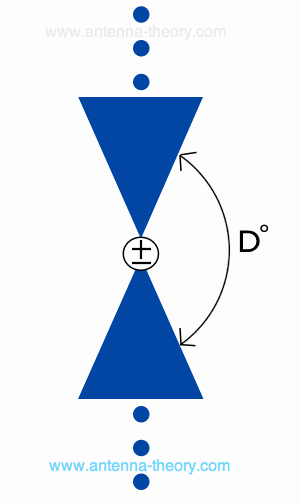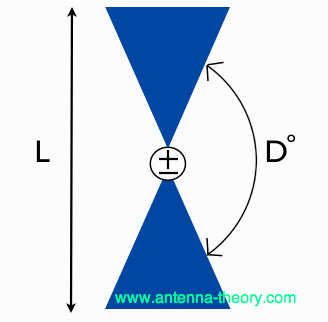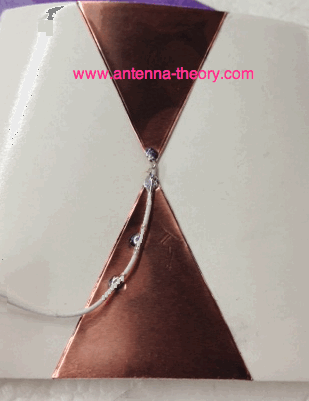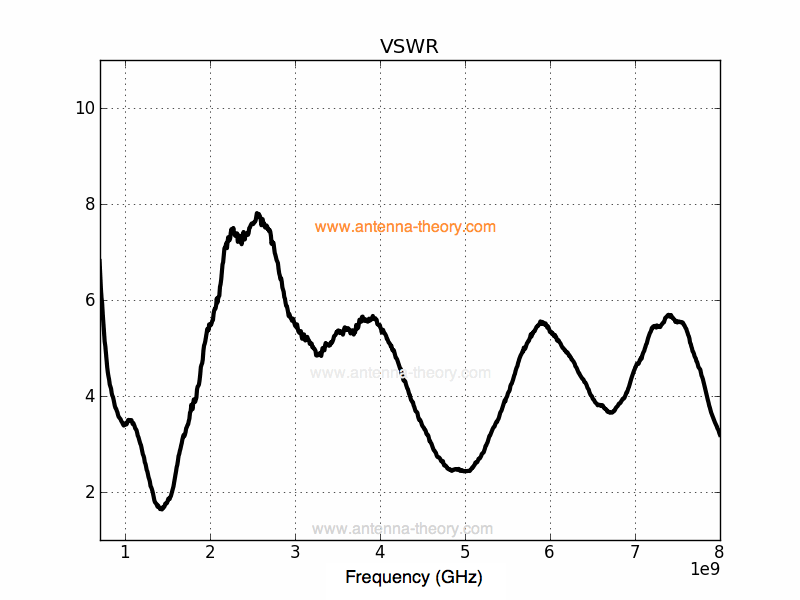Bow Tie Antennas
|
Bow-Tie antennas aren't really Log Periodic antennas; however, the bow tie (or butterfly) antenna makes a good starting point to begin talking about Log-Periodic antennas. So we will first discuss properties of wideband antennas, and then discuss the infinite bow-tie antenna, and then measurements and properties of the real bow-tie antenna. Wideband AntennasIf you think about the Half-Wavelength Dipole Antenna, the antenna design is specified by the length - the length should be equal to a half-wavelength at the frequency of interest. Hence, if you want your antenna to radiate at 300 MHz (1 wavelength at 300 MHz = 1 meter), you would make the antenna 0.5 meters long. Now, this is fine for 300 MHz - but what if you also want the antenna to radiate well at 200 and 400MHz? Because at 200 MHz the 0.5 meter antenna is too short (wavlength at 200 MHz = 1.5 meters) and at 400 MHz the 0.5 meter antenna is too long (wavelength at 400 MHz = 0.75 meters), we won't get efficient radiation at these frequencies. If you think about that last paragraph for a while, you may note that one problem with the above Half-Wavelength antenna design is that the design depends solely on length, which will mean much different things in terms of wavelengths at different frequencies. What if instead, we could design an antenna that was completely specified by Angles instead of Lengths? Angles do not depend on distance - and hence don't depend on wavelength, so if we could design such an antenna it would be frequency independent. The Bow-Tie AntennaAs a simple (and non-manufacturable) infinitely wideband antenna, let's look at an infinite bow-tie antenna:
 Figure 1. Infinitely Long Bow-Tie Antenna. In Figure 1, we have an antenna that is specified solely by the angle between the two metal pieces, D. The antenna feed (where the radio positive and negative terminals connect to the antenna) is at the center of the antenna. Our antenna here is infinitely long in both directions, so that wavelength never comes into the equation. As a result, this antenna would theoretically have an infinite bandwidth, because if it works at one frequency (any frequency), it must work at ALL frequencies, because the antenna looks the same at all wavelengths. This is a nice antenna. In terms of making a real antenna, we can take the simple approach and just clip it after some distance and seeing what happens. The result is the bow-tie antenna (also known as a butterfly antenna, or a biconical antenna):
 Figure 2. The Bow Tie Antenna. This antenna will have a similar radiation pattern to the dipole antenna, and will have vertical polarization. A L=76.5mm Bow Tie antenna with width W=36mm (so that the angle D=2*atan( 76.5/36 )= 130 degrees). This antenna was mocked up as shown in Figure 3:
 Figure 3. A 76.5mm Bow Tie Antenna. The real bow tie antenna of Figure 3 is fed with a coaxial cable. The coaxial cable is soldered along the lower arm of the antenna - the purpose of this is to minimize the impact of the antenna feed cable on the antenna. This is similar to using a balun. The VSWR of the Bow Tie antenna of Figure 3 is shown in Figure 4:
 Figure 4. VSWR of the Bow Tie Antenna of Figure 3. Our bowtie antenna of Figure 3 is L=76.5mm long, which would be a half-wavelength at f=c/2/L=1.96 GHz. We see the first resonance occurs at about 1.5 GHz. The reason this occurs lower than 1.96 GHz is because the antenna is very wide at the top - this essentially makes the antenna behave as if it is longer than it really is. This will be true of non-thin-wire antennas in general.
From Figure 4, we see that the bow-tie antenna has much better bandwidth than a thin-wire dipole antenna. In general, antennas with more volume have wider bandwidth (and I've said this many times on this site, as it is one of the fundamental antenna rules). More radiation modes can fit on the structure when the current is less constrained. The VSWR=3:1 bandwidth for the 1.5GHz mode is from fLow=1.18GHz to fHigh=1.65 GHz. This produces a Fractional Bandwidth of 33%. Note that the fractional bandwidth of a thin wire dipole antenna is about 8%. Hence, we see the bow tie has a much larger bandwidth than the dipole antenna. Since this antenna is easy to construct, it is very popular for this reason. Note that a low VSWR does not necessarily imply radiation - the power could be absorbed or lost. Low VSWR means power is being delivered to the antenna and not being reflected. However, in this case, where we have no real non-metal materials (no lossy dielectrics, and all metals are good conductors) then it is reasonable to assume most of the energy is being radiated (which it is). Now that we have discussed the bow tie antenna, we can extend some of the wideband concepts here to a very popular and useful extension, the Log-Periodic tooth antenna. The bow tie can be considered a simplified version of the LP tooth.
Antenna Tutorial (Home)
|